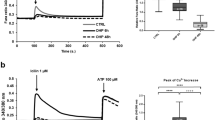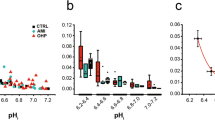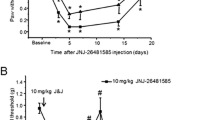Abstract
Peripheral neuropathy is the most frequent dose-limiting adverse effect of oxaliplatin. Acute pain symptoms that are induced or exacerbated by cold occur in almost all patients immediately following the first infusions. Evidence has shown that oxaliplatin causes ion channel expression modulations in dorsal root ganglia neurons, which are thought to contribute to peripheral hypersensitivity. Most dysregulated genes encode ion channels involved in cold and mechanical perception, noteworthy members of a sub-group of potassium channels of the K2P family, TREK and TRAAK. Downregulation of these K2P channels has been identified as an important tuner of acute oxaliplatin-induced hypersensitivity. We investigated the molecular mechanisms underlying this peripheral dysregulation in a murine model of neuropathic pain triggered by a single oxaliplatin administration. We found that oxaliplatin-mediated TREK-TRAAK downregulation, as well as downregulation of other K+ channels of the K2P and Kv families, involves a transcription factor known as the neuron-restrictive silencer factor (NRSF) and its epigenetic co-repressors histone deacetylases (HDACs). NRSF knockdown was able to prevent most of these K+ channel mRNA downregulation in mice dorsal root ganglion neurons as well as oxaliplatin-induced acute cold and mechanical hypersensitivity. Interestingly, pharmacological inhibition of class I HDAC reproduces the antinociceptive effects of NRSF knockdown and leads to an increased K+ channel expression in oxaliplatin-treated mice.




Similar content being viewed by others
References
Andre T, Boni C, Mounedji-Boudiaf L, Navarro M, Tabernero J, Hickish T et al (2004) Oxaliplatin, fluorouracil, and leucovorin as adjuvant treatment for colon cancer. N Engl J Med 350(23):2343–2351
Attal N, Bouhassira D, Gautron M, Vaillant JN, Mitry E, Lepere C et al (2009) Thermal hyperalgesia as a marker of oxaliplatin neurotoxicity: a prospective quantified sensory assessment study. Pain. 144(3):245–252
Cersosimo RJ (2005) Oxaliplatin-associated neuropathy: a review. Ann Pharmacother 39(1):128–135
Krishnan AV, Goldstein D, Friedlander M, Kiernan MC (2005) Oxaliplatin-induced neurotoxicity and the development of neuropathy. Muscle Nerve 32(1):51–60
Pasetto LM, D’Andrea MR, Rossi E, Monfardini S (2006) Oxaliplatin-related neurotoxicity: how and why? Crit Rev Oncol Hematol 59(2):159–168
Argyriou AA, Polychronopoulos P, Iconomou G, Chroni E, Kalofonos HP (2008) A review on oxaliplatin-induced peripheral nerve damage. Cancer Treat Rev 34(4):368–377
de Gramont A, Figer A, Seymour M, Homerin M, Hmissi A, Cassidy J, Boni C, Cortes-Funes H et al (2000) Leucovorin and fluorouracil with or without oxaliplatin as first-line treatment in advanced colorectal cancer. J Clin Oncol 18(16):2938–2947
Land SR, Kopec JA, Cecchini RS, Ganz PA, Wieand HS, Colangelo LH, Murphy K, Kuebler JP et al (2007) Neurotoxicity from oxaliplatin combined with weekly bolus fluorouracil and leucovorin as surgical adjuvant chemotherapy for stage II and III colon cancer: NSABP C-07. J Clin Oncol 25(16):2205–2211
Park SB, Lin CS, Krishnan AV, Goldstein D, Friedlander ML, Kiernan MC (2011) Long-term neuropathy after oxaliplatin treatment: challenging the dictum of reversibility. Oncologist. 16(5):708–716
Pietrangeli A, Leandri M, Terzoli E, Jandolo B, Garufi C (2006) Persistence of high-dose oxaliplatin-induced neuropathy at long-term follow-up. Eur Neurol 56(1):13–16
Cavaletti G, Tredici G, Petruccioli MG, Donde E, Tredici P, Marmiroli P et al (2001) Effects of different schedules of oxaliplatin treatment on the peripheral nervous system of the rat. Eur J Cancer 37(18):2457–2463
Jamieson SM, Liu J, Connor B, McKeage MJ (2005) Oxaliplatin causes selective atrophy of a subpopulation of dorsal root ganglion neurons without inducing cell loss. Cancer Chemother Pharmacol 56(4):391–399
Xiao WH, Zheng H, Bennett GJ (2012) Characterization of oxaliplatin-induced chronic painful peripheral neuropathy in the rat and comparison with the neuropathy induced by paclitaxel. Neuroscience. 203:194–206
Grolleau F, Gamelin L, Boisdron-Celle M, Lapied B, Pelhate M, Gamelin E (2001) A possible explanation for a neurotoxic effect of the anticancer agent oxaliplatin on neuronal voltage-gated sodium channels. J Neurophysiol 85(5):2293–2297
Kawashiri T, Egashira N, Kurobe K, Tsutsumi K, Yamashita Y, Ushio S et al (2012) L type Ca(2)+ channel blockers prevent oxaliplatin-induced cold hyperalgesia and TRPM8 overexpression in rats. Mol Pain 8:7
Park SB, Lin CS, Krishnan AV, Goldstein D, Friedlander ML, Kiernan MC (2011) Dose effects of oxaliplatin on persistent and transient Na+ conductances and the development of neurotoxicity. PLoS One 6(4):e18469
Descoeur J, Pereira V, Pizzoccaro A, Francois A, Ling B, Maffre V, Couette B, Busserolles J et al (2011) Oxaliplatin-induced cold hypersensitivity is due to remodelling of ion channel expression in nociceptors. EMBO Mol Med 3(5):266–278
Gauchan P, Andoh T, Kato A, Kuraishi Y (2009) Involvement of increased expression of transient receptor potential melastatin 8 in oxaliplatin-induced cold allodynia in mice. Neurosci Lett 458(2):93–95
Nassini R, Gees M, Harrison S, De Siena G, Materazzi S, Moretto N et al (2011) Oxaliplatin elicits mechanical and cold allodynia in rodents via TRPA1 receptor stimulation. Pain. 152(7):1621–1631
Pereira V, Busserolles J, Christin M, Devilliers M, Poupon L, Legha W, Alloui A, Aissouni Y et al (2014) Role of the TREK2 potassium channel in cold and warm thermosensation and in pain perception. Pain. 155(12):2534–2544
Alloui A, Zimmermann K, Mamet J, Duprat F, Noel J, Chemin J et al (2006) TREK-1, a K+ channel involved in polymodal pain perception. EMBO J 25(11):2368–2376
Noel J, Zimmermann K, Busserolles J, Deval E, Alloui A, Diochot S et al (2009) The mechano-activated K+ channels TRAAK and TREK-1 control both warm and cold perception. EMBO J 28(9):1308–1318
Vivier D, Soussia IB, Rodrigues N, Lolignier S, Devilliers M, Chatelain FC, Prival L, Chapuy E et al (2017) Development of the first two-pore domain potassium channel TWIK-related K+ channel 1-selective agonist possessing in vivo antinociceptive activity. J Med Chem 60(3):1076–1088
Busserolles J, Tsantoulas C, Eschalier A, Lopez Garcia JA (2016) Potassium channels in neuropathic pain: advances, challenges, and emerging ideas. Pain. 157(Suppl 1):S7–S14
Uchida H, Ma L, Ueda H (2010) Epigenetic gene silencing underlies C-fiber dysfunctions in neuropathic pain. J Neurosci 30(13):4806–4814
Wang D, Yu J (2016) Negative regulation of REST on NR2B in spinal cord contributes to the development of bone cancer pain in mice. Oncotarget. 7(51):85564–85572
Willis DE, Wang M, Brown E, Fones L, Cave JW (2016) Selective repression of gene expression in neuropathic pain by the neuron-restrictive silencing factor/repressor element-1 silencing transcription (NRSF/REST). Neurosci Lett 625:20–25
Zhang F, Gigout S, Liu Y, Wang Y, Hao H, Buckley NJ, Zhang H, Wood IC et al (2019) Repressor element 1-silencing transcription factor drives the development of chronic pain states. Pain. 160(10):2398–2408
Zhu C, Tang J, Ding T, Chen L, Wang W, Mei XP, He XT, Wang W et al (2017) Neuron-restrictive silencer factor-mediated downregulation of mu-opioid receptor contributes to the reduced morphine analgesia in bone cancer pain. Pain. 158(5):879–890
Qureshi IA, Gokhan S, Mehler MF (2010) REST and CoREST are transcriptional and epigenetic regulators of seminal neural fate decisions. Cell Cycle 9(22):4477–4486
Andres ME, Burger C, Peral-Rubio MJ, Battaglioli E, Anderson ME, Grimes J, Dallman J, Ballas N et al (1999) CoREST: a functional corepressor required for regulation of neural-specific gene expression. Proc Natl Acad Sci U S A 96(17):9873–9878
You A, Tong JK, Grozinger CM, Schreiber SL (2001) CoREST is an integral component of the CoREST- human histone deacetylase complex. Proc Natl Acad Sci U S A 98(4):1454–1458
Uchida H, Sasaki K, Ma L, Ueda H (2010) Neuron-restrictive silencer factor causes epigenetic silencing of Kv4.3 gene after peripheral nerve injury. Neuroscience. 166(1):1–4
Uchida H, Matsushita Y, Araki K, Mukae T, Ueda H (2015) Histone deacetylase inhibitors relieve morphine resistance in neuropathic pain after peripheral nerve injury. J Pharmacol Sci 128(4):208–211
Bruce AW, Donaldson IJ, Wood IC, Yerbury SA, Sadowski MI, Chapman M, Gottgens B, Buckley NJ (2004) Genome-wide analysis of repressor element 1 silencing transcription factor/neuron-restrictive silencing factor (REST/NRSF) target genes. Proc Natl Acad Sci U S A 101(28):10458–10463
Heurteaux C, Guy N, Laigle C, Blondeau N, Duprat F, Mazzuca M, Lang-Lazdunski L, Widmann C et al (2004) TREK-1, a K+ channel involved in neuroprotection and general anesthesia. EMBO J 23(13):2684–2695
Guyon A, Tardy MP, Rovere C, Nahon JL, Barhanin J, Lesage F (2009) Glucose inhibition persists in hypothalamic neurons lacking tandem-pore K+ channels. J Neurosci 29(8):2528–2533
Janssen PA, Niemegeers CJ, Dony JG (1963) The inhibitory effect of fentanyl and other morphine-like analgesics on the warm water induced tail withdrawl reflex in rats. Arzneimittelforschung. 13:502–507
Yalcin I, Charlet A, Freund-Mercier MJ, Barrot M, Poisbeau P (2009) Differentiating thermal allodynia and hyperalgesia using dynamic hot and cold plate in rodents. J Pain 10(7):767–773
Hylden JL, Wilcox GL (1980) Intrathecal morphine in mice: a new technique. Eur J Pharmacol 67(2-3):313–316
Saramaki A, Banwell CM, Campbell MJ, Carlberg C (2006) Regulation of the human p21(waf1/cip1) gene promoter via multiple binding sites for p53 and the vitamin D3 receptor. Nucleic Acids Res 34(2):543–554
Matys V, Fricke E, Geffers R, Gossling E, Haubrock M, Hehl R et al (2003) TRANSFAC: transcriptional regulation, from patterns to profiles. Nucleic Acids Res 31(1):374–378
Sandoz G, Thummler S, Duprat F, Feliciangeli S, Vinh J, Escoubas P et al (2006) AKAP150, a switch to convert mechano-, pH- and arachidonic acid-sensitive TREK K(+) channels into open leak channels. EMBO J 25(24):5864–5872
Sandoz G, Tardy MP, Thummler S, Feliciangeli S, Lazdunski M, Lesage F (2008) Mtap2 is a constituent of the protein network that regulates twik-related K+ channel expression and trafficking. J Neurosci 28(34):8545–8552
Formisano L, Guida N, Valsecchi V, Cantile M, Cuomo O, Vinciguerra A, Laudati G, Pignataro G et al (2015) Sp3/REST/HDAC1/HDAC2 complex represses and Sp1/HIF-1/p300 complex activates ncx1 gene transcription, in brain ischemia and in ischemic brain preconditioning, by epigenetic mechanism. J Neurosci 35(19):7332–7348
Leus NG, van den Bosch T, van der Wouden PE, Krist K, Ourailidou ME, Eleftheriadis N et al (2017) HDAC1-3 inhibitor MS-275 enhances IL10 expression in RAW264.7 macrophages and reduces cigarette smoke-induced airway inflammation in mice. Sci Rep 7:45047
Beckers T, Burkhardt C, Wieland H, Gimmnich P, Ciossek T, Maier T, Sanders K (2007) Distinct pharmacological properties of second generation HDAC inhibitors with the benzamide or hydroxamate head group. Int J Cancer 121(5):1138–1148
Bai G, Wei D, Zou S, Ren K, Dubner R (2010) Inhibition of class II histone deacetylases in the spinal cord attenuates inflammatory hyperalgesia. Mol Pain 6:51
Zhou J, Yang CX, Zhong JY, Wang HB (2013) Intrathecal TRESK gene recombinant adenovirus attenuates spared nerve injury-induced neuropathic pain in rats. Neuroreport. 24(3):131–136
Cao XH, Byun HS, Chen SR, Cai YQ, Pan HL (2010) Reduction in voltage-gated K+ channel activity in primary sensory neurons in painful diabetic neuropathy: role of brain-derived neurotrophic factor. J Neurochem 114(5):1460–1475
Chen SR, Cai YQ, Pan HL (2009) Plasticity and emerging role of BKCa channels in nociceptive control in neuropathic pain. J Neurochem 110(1):352–362
Rasband MN, Park EW, Vanderah TW, Lai J, Porreca F, Trimmer JS (2001) Distinct potassium channels on pain-sensing neurons. Proc Natl Acad Sci U S A 98(23):13373–13378
Rose K, Ooi L, Dalle C, Robertson B, Wood IC, Gamper N (2011) Transcriptional repression of the M channel subunit Kv7.2 in chronic nerve injury. Pain. 152(4):742–754
Dionisi M, Ruffinatti FA, Riva B, Lim D, Canta A, Meregalli C et al (2020) Early stimulation of TREK channel transcription and activity induced by oxaliplatin-dependent cytosolic acidification. Int J Mol Sci 21(19):7164
Castellanos A, Pujol-Coma A, Andres-Bilbe A, Negm A, Callejo G, Soto D, Noël J, Comes N et al (2020) TRESK background K(+) channel deletion selectively uncovers enhanced mechanical and cold sensitivity. J Physiol 598(5):1017–1038
Wang Y, Liu C, Guo QL, Yan JQ, Zhu XY, Huang CS, Zou WY (2011) Intrathecal 5-azacytidine inhibits global DNA methylation and methyl- CpG-binding protein 2 expression and alleviates neuropathic pain in rats following chronic constriction injury. Brain Res 1418:64–69
Zhang Z, Cai YQ, Zou F, Bie B, Pan ZZ (2011) Epigenetic suppression of GAD65 expression mediates persistent pain. Nat Med 17(11):1448–1455
Tochiki KK, Cunningham J, Hunt SP, Geranton SM (2012) The expression of spinal methyl-CpG-binding protein 2, DNA methyltransferases and histone deacetylases is modulated in persistent pain states. Mol Pain 8:14
Schoenherr CJ, Anderson DJ (1995) The neuron-restrictive silencer factor (NRSF): a coordinate repressor of multiple neuron-specific genes. Science. 267(5202):1360–1363
Otto SJ, McCorkle SR, Hover J, Conaco C, Han JJ, Impey S et al (2007) A new binding motif for the transcriptional repressor REST uncovers large gene networks devoted to neuronal functions. J Neurosci 27(25):6729–6739
Zhang J, Chen SR, Chen H, Pan HL (2018) RE1-silencing transcription factor controls the acute-to-chronic neuropathic pain transition and Chrm2 receptor gene expression in primary sensory neurons. J Biol Chem 293(49):19078–19091
Alani B, Salehi R, Sadeghi P, Khodagholi F, Digaleh H, Jabbarzadeh-Tabrizi S, Zare M, Korbekandi H (2015) Silencing of Hsp70 intensifies 6-OHDA-induced apoptosis and Hsp90 upregulation in PC12 cells. J Mol Neurosci 55(1):174–183
Alani B, Salehi R, Sadeghi P, Zare M, Khodagholi F, Arefian E, Hakemi MG, Digaleh H (2014) Silencing of Hsp90 chaperone expression protects against 6-hydroxydopamine toxicity in PC12 cells. J Mol Neurosci 52(3):392–402
Mucha M, Ooi L, Linley JE, Mordaka P, Dalle C, Robertson B, Gamper N, Wood IC (2010) Transcriptional control of KCNQ channel genes and the regulation of neuronal excitability. J Neurosci 30(40):13235–13245
Phuket TR, Covarrubias M (2009) Kv4 channels underlie the subthreshold-operating A-type K-current in nociceptive dorsal root ganglion neurons. Front Mol Neurosci 2:3
Ueda H (2006) Molecular mechanisms of neuropathic pain-phenotypic switch and initiation mechanisms. Pharmacol Ther 109(1-2):57–77
Ooi L, Wood IC (2007) Chromatin crosstalk in development and disease: lessons from REST. Nat Rev Genet 8(7):544–554
Matsushita Y, Araki K, Omotuyi O, Mukae T, Ueda H (2013) HDAC inhibitors restore C-fibre sensitivity in experimental neuropathic pain model. Br J Pharmacol 170(5):991–998
Formisano L, Guida N, Laudati G, Mascolo L, Di Renzo G, Canzoniero LM (2015) MS-275 inhibits aroclor 1254-induced SH-SY5Y neuronal cell toxicity by preventing the formation of the HDAC3/REST complex on the synapsin-1 promoter. J Pharmacol Exp Ther 352(2):236–243
Bardai FH, Price V, Zaayman M, Wang L, D’Mello SR (2012) Histone deacetylase-1 (HDAC1) is a molecular switch between neuronal survival and death. J Biol Chem 287(42):35444–35453
Bardai FH, D’Mello SR (2011) Selective toxicity by HDAC3 in neurons: regulation by Akt and GSK3beta. J Neurosci 31(5):1746–1751
Denk F, Huang W, Sidders B, Bithell A, Crow M, Grist J, Sharma S, Ziemek D et al (2013) HDAC inhibitors attenuate the development of hypersensitivity in models of neuropathic pain. Pain. 154(9):1668–1679
Danaher RJ, Zhang L, Donley CJ, Laungani NA, Hui SE, Miller CS et al (2018) Histone deacetylase inhibitors prevent persistent hypersensitivity in an orofacial neuropathic pain model. Mol Pain 14:1744806918796763
Vaiopoulos AG, Athanasoula K, Papavassiliou AG (2014) Epigenetic modifications in colorectal cancer: molecular insights and therapeutic challenges. Biochim Biophys Acta 1842(7):971–980
Ikehata M, Ogawa M, Yamada Y, Tanaka S, Ueda K, Iwakawa S (2014) Different effects of epigenetic modifiers on the cytotoxicity induced by 5-fluorouracil, irinotecan or oxaliplatin in colon cancer cells. Biol Pharm Bull 37(1):67–73
Shah P, Gau Y, Sabnis G (2014) Histone deacetylase inhibitor entinostat reverses epithelial to mesenchymal transition of breast cancer cells by reversing the repression of E-cadherin. Breast Cancer Res Treat 143(1):99–111
Ji M, Lee EJ, Kim KB, Kim Y, Sung R, Lee SJ et al (2015) HDAC inhibitors induce epithelial-mesenchymal transition in colon carcinoma cells. Oncol Rep 33(5):2299–2308
Tomono T, Machida T, Kamioka H, Shibasaki Y, Yano K, Ogihara T (2018) Entinostat reverses P-glycoprotein activation in snail-overexpressing adenocarcinoma HCC827 cells. PLoS One 13(7):e0200015
Acknowledgements
We would like to thank Florian Lesage (IPMC, Nice, France) who provided us with the triple TREK-TRAAK knockout mice, and Yoan Renaud who performed the in silico data analysis using the TRANSFAC and FIMO programs.
Data Availability Statement
Data will be made available on a reasonable request.
Funding
This project was funded by the Regional Council of Auvergne (Conseil Régional d’Auvergne) together with the European Fund for Regional Economic Development (FEDER), Clermont Auvergne University, and the French government through the programme “Investissements d’Avenir” (I-Site CAP 20-25).
Author information
Authors and Affiliations
Contributions
V.P. and S. Lamoine conducted the experiments, analyzed the data, and participated in the preparation of the manuscript. M.C., Y.A., and L.P. participated in experiments. S. Lolignier, D.B., and A.P. were associated with the design and analysis of the research. J.B., A.E., and E.B. designed the research, supervised the project, participated in data analysis, and wrote the paper.
Corresponding author
Ethics declarations
All the animal procedures were approved by the local Animal Ethics Committee and the experiments were performed according to the guidelines provided by the European Community on the care and use of animals (Directive 2010/63/EU).
Consent to Participate
Not applicable
Consent for Publication
Not applicable
Conflict of Interest
The authors declare no competing interests.
Additional information
Publisher’s Note
Springer Nature remains neutral with regard to jurisdictional claims in published maps and institutional affiliations.
Vanessa Pereira and Sylvain Lamoine are co-first author.
Supplementary Information
ESM 1
(DOCX 827 kb)
Rights and permissions
About this article
Cite this article
Pereira, V., Lamoine, S., Cuménal, M. et al. Epigenetics Involvement in Oxaliplatin-Induced Potassium Channel Transcriptional Downregulation and Hypersensitivity. Mol Neurobiol 58, 3575–3587 (2021). https://doi.org/10.1007/s12035-021-02361-6
Received:
Accepted:
Published:
Issue Date:
DOI: https://doi.org/10.1007/s12035-021-02361-6




